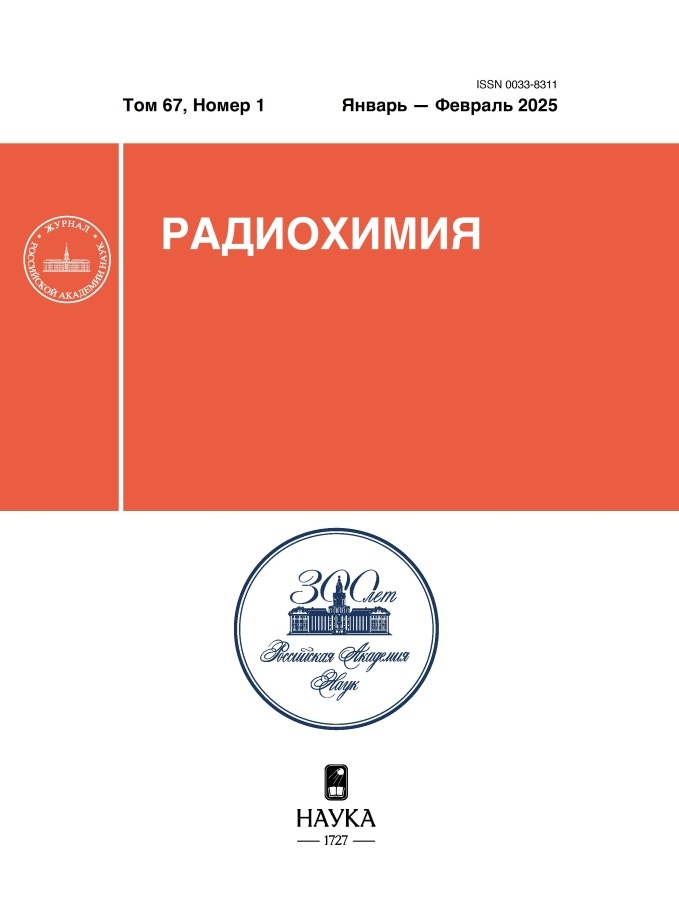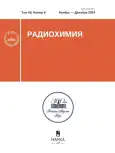Sorbent for extraction-chromatographic separation of lanthanides, based on Prefilter resin impregnated with 2-ethylhexylposphonic acid mono-2-ethylhexyl ester
- Authors: Bobrovskaya K.S.1, Kuznetsov R.A.1, Lisova M.N.1, Fomin A.N.1
-
Affiliations:
- Kapitsa Research Institute of Technology, Ulyanovsk State University
- Issue: Vol 66, No 6 (2024)
- Pages: 556-565
- Section: Articles
- URL: https://gynecology.orscience.ru/0033-8311/article/view/681269
- DOI: https://doi.org/10.31857/S0033831124060064
- ID: 681269
Cite item
Abstract
The characteristics of the sorbent for extraction-chromatographic separation of lanthanides, made by impregnating Prefilter resin with mono-2-ethylhexyl ether of 2-ethylhexylphosphonic acid, have been studied. Using the example of Yb and Lu separation, it is shown that sorption from nitric acid solutions ([HNO3] < 4 M) under static conditions can be described by the linear dependence of the logarithm of the lanthanide distribution ratio on the acidity of the solution. Under dynamic conditions, the elution rate of the mobile phase has the most significant effect on the efficiency of separation of Yb and Lu. The temperature and particle size of the sorbent have weaker influence. A comparison of the characteristics of the proposed sorbent and its analog, the LN2 sorbent (EiChrom, USA), showed their identity. It is shown that the Prefilter based sorbent provides a lower (compared to LN2) leachability of the extractant.
Full Text
About the authors
K. S. Bobrovskaya
Kapitsa Research Institute of Technology, Ulyanovsk State University
Email: rostislavkuznetsov@yandex.ru
Russian Federation, Ulysanovsk
R. A. Kuznetsov
Kapitsa Research Institute of Technology, Ulyanovsk State University
Author for correspondence.
Email: rostislavkuznetsov@yandex.ru
Russian Federation, Ulysanovsk
M. N. Lisova
Kapitsa Research Institute of Technology, Ulyanovsk State University
Email: rostislavkuznetsov@yandex.ru
Russian Federation, Ulysanovsk
A. N. Fomin
Kapitsa Research Institute of Technology, Ulyanovsk State University
Email: rostislavkuznetsov@yandex.ru
Russian Federation, Ulysanovsk
References
- Van de Voorde M., Van Hecke K., Cardinaels T., Binnemans K. // Coord. Chem. Rev. 2019. Vol. 382. P. 103. https://doi.org/10.1016/j.ccr.2018.11.007
- Salek N., Vosoughi S., Afshar P., Salehi B.M., Mehrabi M. // J. Nucl. Res. Appl. 2022. Vol. 2. N 3. P. 28. https://doi.org/10.24200/jon.2022.1024
- Kabay N., Cortina J.L., Trochimczuk A., Streat M. // React. Funct. Polym. 2010. Vol. 70. P. 484. https://doi.org/10.1016/j.reactfunctpolym.2010.01.005
- Shenxu Bao, Yongping Tang, Yimin Zhang, Liang Liang // Chem. Eng. Technol. 2016. Vol. 39. N 8. P. 1377. https://doi.org/10.1002/ceat.201500324
- Sanku M.G., Forsberg K., Svärd M. // J. Chromatogr. A. 2022. Vol. 1676. ID 463278. https://doi.org/10.1016/j.chroma.2022.463278
- Monroy-Guzman F., del Carmen de la Cruz Barba C., Jaime Salinas E., Garibay-Feblés V., Entzana T.N.N. // Metals. 2020. Vol. 10. P. 1390.
- Сайт компании Eichrom, https://www.eichrom.com/products/ln-resins/ Дата обращения 05.06.2024.
- Сайт компании Triskem, https://www.triskem-international.com/scripts/files/6215151d0db8b5.49670533/ PS_TK211-Resin_EN_220222.pdf Дата обращения 05.06.2024.
- Smith C.D., Dietz M.L. // Talanta. 2021. Vol. 222. ID 121541. https://doi.org/10.1016/j.talanta.2020.121541
- Smith C.D., Momen Md.A., Salske S.C., Dietz M. // Microchem. J. 2023. Vol. 193. ID 109175. https://doi.org/10.1016/j.microc.2023.109175
- Drader J.A., Zhu L., Smith P., McCann K., Boyes S., Braley J.C. // Sep. Purif. Technol. 2016. Vol. 163. P. 352. https://doi.org/10.1016/j.seppur.2016.03.005
- Nishihama S., Harano T., Yoshizuka K. // Sep. Sci. Technol. 2017. Vol. 53. N 7. P. 1027. https://doi.org/10.1080/01496395.2017.1310895
- Monroy-Guzman F., Barreiro F.J., Salinas E.J., Treviño A.L.V. // World J. Nucl. Sci. Technol. 2015. Vol. 5. P. 111. http://doi.org/10.4236/wjnst.2015.52011
- Horwitz E.P., McAlister D.R., Dietz M.L. // Sep. Sci. Technol. 2006. Vol. 41. N 10. P. 2163. http://dx.doi.org/10.1080/01496390600742849
- Bertelsen E.R., Jackson J.A., Shafer J.C. // Solvent Extr. Ion Exch. 2020. Vol. 38. N 3. P. 251. https://doi.org/10.1080/07366299.2020.1720958
- Сайт компании TrisKem International, https://www.triskem-international.com/ scripts/files/5f4634457e5157.33298423/ PS_Prefilter-Resin_EN_160927.pdf. Дата обращения 28.02.2024.
- Сайт компании Eichrom. https://www.eichrom.com/wp-content/uploads/2018/03/Prefilter-Bulk-and-Cartridge.pdf
- Qi D. // Hydrometallurgy of Rare Earths. Elsevier, 2018. P. 187–389. https://doi.org/10.1016/B978-0-12-813920-2.00002-7
- Zhengshui H., Ying P., Wanwa M., Xun F. // Solvent Extr. Ion Exch. 1995. Vol. 13. P. 965. https://doi.org/10.1080/07366299508918312
- Horwitz E.P., Bloomquist C.A.A. // J. Inorg. Nucl. Chem. 1972. Vol. 34. N 12. P. 3851. https://doi.org/10.1016/0022-1902(72)80033-2
- Амбул Е.В., Голецкий Н.Д., Медведева А.И., Наумов А.А., Пузиков Е.А., Афонин М.А., Шишкин Д.Н. // Радиохимия. 2022. Т. 64. № 3. С. 233. doi: 10.31857/S0033831122030054
- Horwitz E.P., McAlister D.R., Bond A.H., Barrans R.E., Williamson J.M. // Appl. Radiat. Isot. 2005. Vol. 63. P. 23. https://doi.org/10.1016/j.apradiso.2005.02.005
- Алексеев И.Е., Кротов С.А. // Радиохимия. 2023. Т. 65. № 2. C. 172. https://doi.org/10.31857/S0033831123020065
Supplementary files














